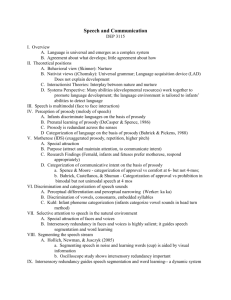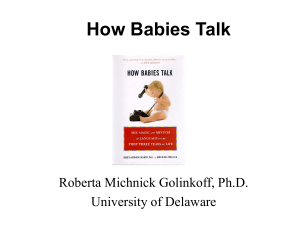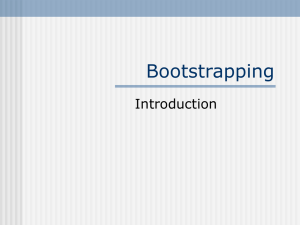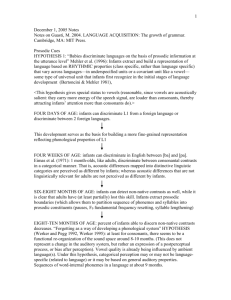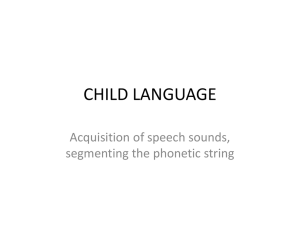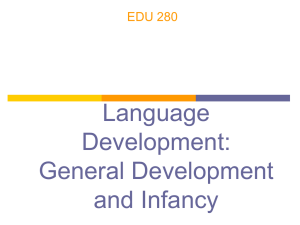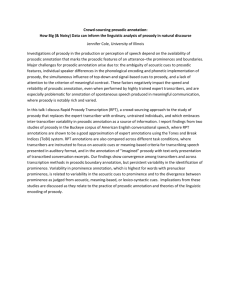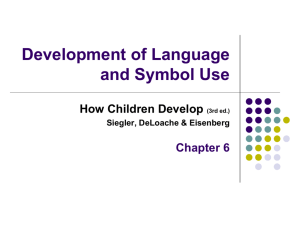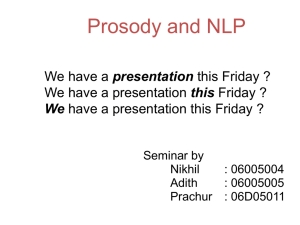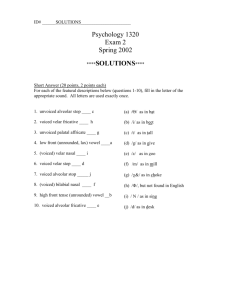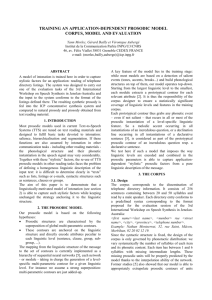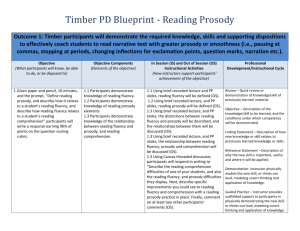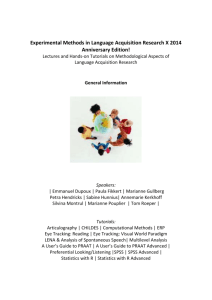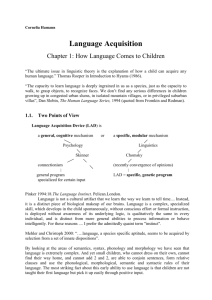Presentation
advertisement
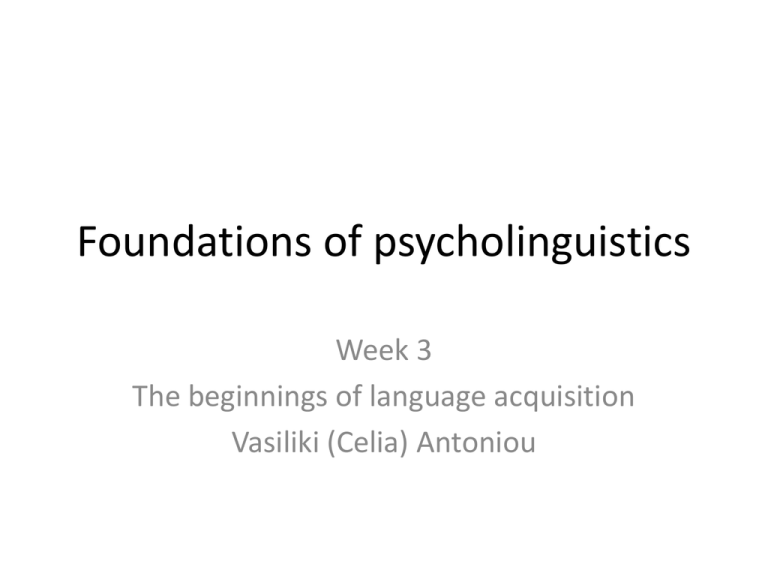
Foundations of psycholinguistics Week 3 The beginnings of language acquisition Vasiliki (Celia) Antoniou Today • Is knowledge about prosody useful to the newborn language learner? • Are newborns able to perceive speech in terms of syllables? • Do we have some sort of genetic predisposition to understand speech in a certain way? Beginnings of language acquisition • What characteristics do children need to learn for their native language? 1. Phonology 2. Syntax 3. Meaning What do they need to learn? In terms of phonology... • Sound structure • What does this include?? • Linguistically relevant sounds (i.e. are click sounds relevant?) • The number of sounds in language (i.e. 44 in English) What do they need to learn? In terms of syntax and morphology... • Grammar • The type of language they are learning 1. Isolating? 2. Agglutinative? • Word order (i.e. verb order, etc.) English: I know that I know it French: Je sais que je le sais What do they need to learn? In terms of semantics... • Word meaning • How are certain concepts expressed in a language? Ex. Colour words words for snow (!) Eskimos have 30 different words for snow! The Beginnings of Language Acquisition 1. Learning before birth 2. Neonatal biases 3. Learning about native word stress 4. Prosodic bootstrapping Learning before birth • When does the auditory system start to develop during pregnancy? It develops from the 5th month (i.e. the ears!) and is almost complete by the 7th month. How have we come to learn about this? By measuring fetal heart rate, by noticing movements as indirect signs of fetal interest What are the indications for prenatal speech perception? • Fetus prefers mother’s voice over other voices • Fetus reacts to syllabus reversal: babi babi...biba Thus, infants recognize language by its prosody from 0 months! Neonatal Biases • 2 ways to study them... 1. Near – Infrared spectroscopy 2. High amplitude sucking or else... • 1. 2. Conclusions Neonates show more brain activation for speech than for other, similar sounds Neonates prefer their native language over other languages 2 was proved by which studies? French vs. Russian (Mehler et al. 1988) English vs. Italian (Moon et al. 1993) Thus, babies use the overall prosody (rhythm, intonation) rather than single sounds What is the head turn preference procedure? Word stress perception • Most English words start with a strong / weak syllable? What do we mean by this? Water, calendar, Department, guitar, along, assign, about, important • At what age do English learning babies know this? • 9 months – Prosodic effect!: American babies prefer listening to stress-initial words over stress-final words • Is this the same for all languages?? ➢NO! i.e. Spanish: no overall preference initial stress less dominant than in English • • • CV-CV (náda ‘nothing’): preference for stress-initial CV-CVC (jamón ‘ham’): preference for stress-final Infants adapt to native word stress during the first year Word boundary perception • Word stress is used by infants for word boundary detection at the age of... 7 MONTHS! Process: - familiarisation with monosyllabic words (i.e. dog) - Then, they have exposure to long passages where the familiar words are also used - Infants detect stress-initial words with two syllables (hámlet) at 7 months - At 7 months, overuse of stress leads to missegmen-tations: the guitár is here táris - Infants detect stress-final words (guitár) at 10 months Bootstrapping • How many types? • Prosodic bootstrapping Infants use rhythmic and intonational properties (prosody) to initialise learning in other linguistic areas (i.e. word learning) They try out how the sounds of words are organised and this is why we say that a good example of prosodic bootstrapping is... the overuse of word stress segmentation! Infants recognise their own name from 4 months • Syntactic bootstrapping Syntactic bootstrapping • What is it? The process of understanding phrase structure • Does prosody help in identifying this structure? Yes, clause boundaries are often (but not always) marked by pauses, final syllable lengthening, pitch changes, etc. • 7-month-old babies are sensitive to these markers • Can you add the word boundaries (#) ? Cinderella lived in a great big house,but it was sort of dark because she had this mean, mean, mean stepmother. Syntactic bootstrapping • • • • There’s head directionality as well... What is it?? The place of the most important word in a sentence. Languages can be head initial and head final Head-initial: e.g. English, French, Italian The verb is at the beginning of the verb phrase. John [puts the book on the table]. Head-final: e.g. Turkish, Japanese The verb is at the end of the verb phrase. Jon wa [tēburu-no ue-ni hon-o oite iru]. Jon-[affix] table-[of] top-[by] book-[a] putting-[are] Homework! • Ch. 2 from coursebook (esp. the studies my Mehler) • Think about it... Do we have some sort of genetic predisposition to understand speech in a certain way? Is there something about our ability to perceive speech that is uniquely human?
